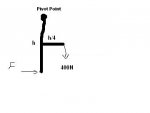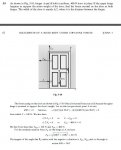You are using an out of date browser. It may not display this or other websites correctly.
You should upgrade or use an alternative browser.
You should upgrade or use an alternative browser.
Door torque problem
- Thread starter ninguen
- Start date
How are they getting (h/4)(400N)(sin90)
T = r x F sin(theta)
r = (h/4) is the distance of the cg of the door from the hinge line. F = 400N is the applied force. Theta is 90 degrees in this case.
T = r x F sin(theta)
r = (h/4) is the distance of the cg of the door from the hinge line. F = 400N is the applied force. Theta is 90 degrees in this case.
I still don't get it.
The way I see it, there is a virtual bar of length h/4 which sticks out perpendicular to the line between the hinges at a distance of h/2. And the 400N force being applied to the end of this bar is parallel to the line between the hinges.
So it seems that the 400N force must be applied at a diagonal angle of some sort.... with some force going downwards and some force going to the left.
How is this not the case?
Here's how I visualize the problem. If it were a L-shape with the h/4 bar at the top hinge, I'd understand how to work this out. But this T-shape adds a level of complexity for me.
Am I looking at this the right way?

EDIT: So working around a bit, and I got the same answer as the book by treating it as an L-shaped lever. But it seems odd to me since the 100N horizontal force is being applied halfway down the door instead of at the top. So it seems to me that the torque should be different as you move downwards.
tldr; I got the right answer, but I'm still confused.
Am I looking at this the right way?

EDIT: So working around a bit, and I got the same answer as the book by treating it as an L-shaped lever. But it seems odd to me since the 100N horizontal force is being applied halfway down the door instead of at the top. So it seems to me that the torque should be different as you move downwards.
tldr; I got the right answer, but I'm still confused.
Last edited:
The way I see it, there is a virtual bar of length h/4 which sticks out perpendicular to the line between the hinges at a distance of h/2. And the 400N force being applied to the end of this bar is parallel to the line between the hinges.
So it seems that the 400N force must be applied at a diagonal angle of some sort.... with some force going downwards and some force going to the left.
How is this not the case?
The 400N force is *downward only* -- there is no component going to the left. It is due strictly to gravity.
Consider your drawing with the conceptual bars. The horizontal bar (h/4 in length) could be attached at the top, middle (where you have drawn it), or bottom -- and the torque it applies to point A would not change. The resultant force F would not change either. It will always be 1/4 of the vertical force, simply because its moment arm, h, is four times greater than the horizontal moment arm, h/4.
The 400N force is *downward only* -- there is no component going to the left. It is due strictly to gravity.
Consider your drawing with the conceptual bars. The horizontal bar (h/4 in length) could be attached at the top, middle (where you have drawn it), or bottom -- and the torque it applies to point A would not change. The resultant force F would not change either. It will always be 1/4 of the vertical force, simply because its moment arm, h, is four times greater than the horizontal moment arm, h/4.
This seems very counter-intuitive to me. But I'm going to believe you. This sounds like a great idea for an experiment later.

